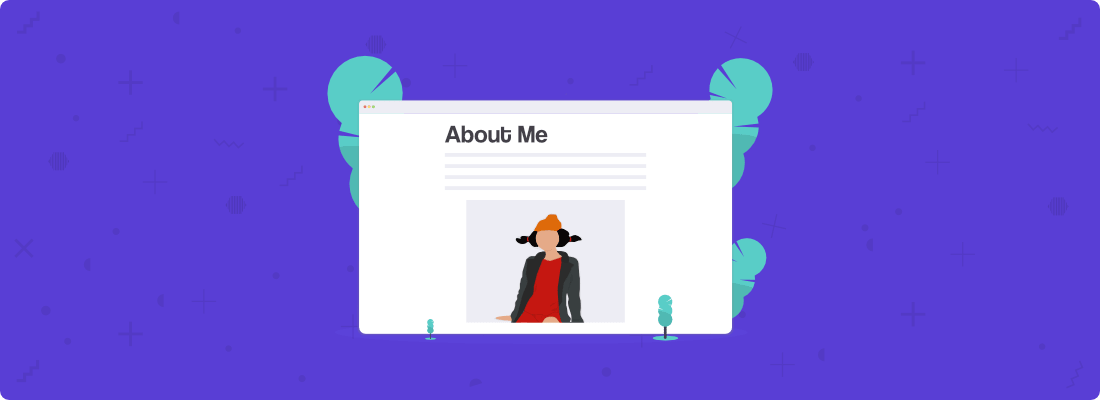Pop quiz! When learning how to write an About page, what do you think the main focus should be?
A. Me, obviously
B. My precious products, because #money
C. My audience
D. What’s an About page?
Did you answer A? You did, didn’t you?
Well, I hate to break it to you, but contrary to what the name says, an About page should actually be about your audience and what you can do for them.

So the correct answer is C.
When learning how to write an About page, many beginner bloggers and entrepreneurs make the mistake of making it all about them.
But not you, because you’re reading this post and are about to learn how to craft the perfect and most engaging About page in the whole universe.
Okay, maybe not the whole universe… but your whole niche.
In this blog post, we’ll go over how to write a killer About Us page, some examples from successful brands, free templates, and more!
Contents
- How to write an about page
- Open like a champ
- Explain what you can do for them
- Tell them who your site’s for
- Explain what they’ll find on your site
- Show them social proof
- Get personal
- Tell them what to do
- Best practices for writing an about page
- Optimizing your about me page for search engines
- About me page examples
Disclosure: You should always assume that pretty much every link on this site is an affiliate link, and if you click it and buy something you like, I’ll earn some money to help me buy a DeLorean, build a time machine, and travel back to the 90s so I can watch Hey Arnold! and eat Dunkaroos again.
An About Me page is a page on your website where visitors can learn more about you, your business, what you offer, your credentials, and how you can help them.
About pages often tell the story of how you got where you are and the challenges you faced.
While blog posts might be the first point of contact between you and your potential customer, a killer About Me page might be what seals the deal.
Before buying your product or service, people will want to know who you are, how you know what you know, and if what you’re offering is actually for them.
Not including an About page or crafting an unprofessional one can lower your conversion rate and make your visitors disappear.
How to Write an About Page [With Free About Me Page Template]

1. Open Like a Champ
A weak or confusing headline can make your visitors bounce faster than Stanley gets in line for pretzel day.
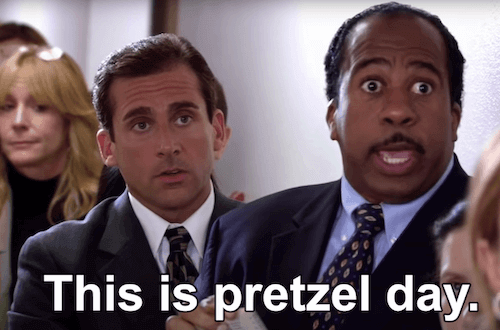
When writing your About Me page’s headline, make sure that it is:
- Clear
- Relevant
- Engaging
- Benefit-driven
You could even include a sub-headline that further explains the benefits your reader will receive.
Remember, this is the first thing your visitors see when they land on your About Me page. You must make a great first impression.
How to Write a Benefit-Driven Headline for Your About Page
Think about what makes you different from your competitors and use it to capture your visitors’ attention.
For example, if you’re a wedding and event photographer teaching others how to book some shoots, you could write something like this:
Up Your Photography Game and Book More Weddings
This headline is great because it tells the visitor exactly what they’re going to get. They’re going to learn how to take better photos and get more clients.
However, most people begin their About Me page like this:
My Name is Michael Scott and Photography is my Passion
This doesn’t provide any valuable information to your reader.
If you have a photography business, chances are your visitor knows that’s your passion. There’s no need to emphasize it.
Remember, it’s not about you, it’s about them.
Grow Your Business on the Side
Free 5-day blogging bootcamp!
2. Explain What You Can Do for Them
The next section in your About Me page should cover why you’re useful to your audience. Go over everything you can do for them.
Most people who land on your About Me page do so because they’re looking for a solution to a problem they’re having.
No one visits your website just to stalk you.
That’s what Facebook’s for.
Yes, they want to learn about you, but what they want to learn about you is how you can help them.
The key to building a successful business is providing value to your customers.
So make sure that you make it clear what the value is that you can give them.
3. Tell Them Who Your Site’s for
Who’s your perfect audience? What kind of people will benefit the most from your product or service?
When people visit your website, you should let them know that they’re in the right place.
As I mentioned before, people who visit your site do so because they have a problem that requires fixing.
You must make sure that they know your business is the solution.
For example, if your target audience are photographers trying to get better or get more clients, you could write something like this:
I help beginner and professional photographers improve their skills, build their brand, and teach them how to book weddings and other events as photographers.
4. Explain What They’ll Find on Your Site
Now that you’ve got your ideal visitor’s attention and told them how you can help them, it’s time to explain what they’ll find on your site.
When learning how to write an About Me page, many beginner bloggers forget to talk about this.
But not you!
Here are a few things you want to let your reader know:
Why They Should Read Your Blog
Using our photography example, you could tell your reader something like:
If you’re passionate about capturing the world with a click, you’ll love it here.
What Your Blog Posts Are About
Are your blog posts motivational? How-to guides? In-depth articles?
For example, on this website I focus on very in-depth articles. My blog posts are not for people who want quick and vague advice.
My target audience are people who are serious about blogging and growing their business.
People who will take the time to read detailed guides and bookmark them for later to learn as much as they can to succeed.
How to Navigate Your Blog
Is there any particular order in which they should read your blog posts?
For example, if you’re a beginner blogger visiting Blogstalgia, I’d have you go through these articles in order:
- How to Start a Blog
- WordPress Tutorial for Beginners
- How to Write a Blog Post
- How to Make Money Blogging
5. Show Them Social Proof
Social proof is great for building trust with your visitors. In fact, adding testimonials will most likely increase your conversion rate.
If you have clients that have worked with you before or people you’ve helped for free, consider asking them if they’d be willing to write you a testimonial.
Another great way to show social proof in your About Me page is to add the logos of websites you’ve been featured in.

You could also add a link to the articles you wrote for them.
Do you have any reviews on your Facebook page? Associations like the Better Business Bureau? Websites like Yelp or Trustpilot? Forums?
Anything that can show credibility should be placed in your About page.
Don’t use fake testimonials, though.
Not only can they damage your reputation, but it’s also illegal, and people could report you to the Federal Trade Commission (FTC).
6. Get Personal
The moment you’ve been waiting for is here!
You can finally tell the reader more about the actual you.
When learning how to write a killer About Us page, many beginner bloggers make the mistake of just listing a bunch of random facts about them.
But that’s not quite what you want to write.
When writing your About page, you must write in a way that matches your brand’s goals.
Here’s what you want to share in this section of your About page:
Share Your Values
Tell people who you are, what your values are, and what you believe in. Explain to them why your product or service is important to you.
If you or your business gives to charity, mention that as well.
Do you often help others without expecting anything back in return – volunteering? Let them know that.
If you have any photos to prove it, don’t be afraid to share them.
Open up to your audience and let them know that there’s a genuine and kind person behind your brand.
For example, on my About Me page, I mention how I love spending summers volunteering with kids and adults with special needs.
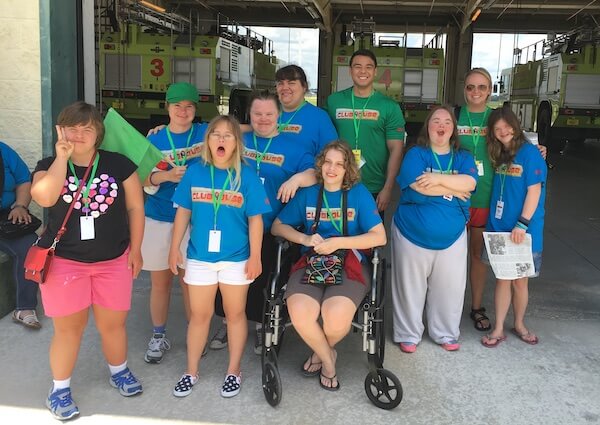
Emotions have a lot of influence in the decision-making process.
Sharing your values in your About page is a great way to win over the hearts of potential customers and help them relate to you and your brand.
Needless to say, you want to be honest about who you are. Don’t make up stories just to get visitors to buy your product or service.
People can often tell if you’re being genuine or not. Plus, truth always finds its way out.
Share Photos of Yourself
Be transparent with people, show them a photo of the person that’s behind the brand. Remember, people buy from people.
While this photo doesn’t have to be super professional, try not to upload a low-quality selfie.
You have no idea how many bloggers I’ve seen claiming to be successful upload a random pixelated photo of themselves.
You would imagine that someone that’s successful would be able to afford a decent headshot, or at least have a friend take it for them.
A low-quality photo is certainly not a good look on you or your brand.
Photos for Bigger Businesses
If you have a business with many co-founders or several authors, you could use your logo or a relevant image to represent everyone instead.
Share the Story of Your Professional Journey
It’s time to hop on the DeLorean and go back in time as far as you need to find all the things that made your brand into what it is today.
Stories are a great way to resonate with people and tell them how you know what you know.
You probably faced many struggles and challenges before getting where you are, right?
Go ahead and share those with your audience.
The best “about” stories are those that your audience can identify themselves with.
Did you create that automated haircut machine because you were tired of having to pay for a haircut every month?
Then share that!
Did you create that self-heating coffee mug because you live in Alaska and your coffee would get cold within a few seconds?
Then tell that to your audience.
7. Tell Them What to Do
When learning how to write an About page, many beginner bloggers and businesses make the mistake of not adding a call-to-action.
A call-to-action (CTA) is something that encourages your readers to… well, take action.
This action could be anything from signing up for your newsletter, to downloading a PDF guide, or connecting with you on social media.
A call-to-action should let your visitors know what to do after they’ve read your About page.
Don’t leave it chance or assume they know. You must guide their every step.
About Page Call-to-Action Best Practices
Here are a few tips to make your call-to-actions convert:
- Make them visually appealing – your CTA should have a color that pops out from your page but still fits with the overall theme.
- Keep them short – don’t make them longer than 5 words.
- Keep them action-oriented – they should compel your visitors to click whatever you’re offering. For example, “Read this next,” “Download the free guide,” “Join us now.”
Call-to-actions are a crucial part of your marketing strategy and should be placed in your blog posts, Homepage, and About page.
But remember, they must always provide value to your audience.
Best Practices for Writing an About Page
When learning how to write an About page, you want to stick to the following best practices:
1. Place the Most Important Info Above the Fold
People have the attention span of a puppy trying to decide what to play with.
Just kidding… we probably have even lower attention spans.
That’s why it’s important to place the most important information on your About page above the fold.
Above the fold is the upper half of your website that’s visible without having scrolling down the page.
Visitors spend 74% of their time looking at information above the fold plus the screenful immediately below the fold, according to data gathered by Nielsen Normal Group.
Beginner bloggers learning how to write an About page often open up with useless information and get to the important stuff later.
But not you!
You’re going to grab your visitors right from the start of your About Me page with the valuable information they want.
2. Add Some Cool Images
We live in a world that’s dominated by visuals.
Truth is, most people will scan your About page and only stop to read if they see something that grabs their attention.
So consider using images or infographics to give your About page some color and make a bigger impression on your visitors.
I would avoid using stock photos, though, as they can look generic.
As I mentioned earlier, don’t be afraid to show your audience who you are. Include a photo of yourself or employees if appropriate.
In fact, adding a photo of people has been shown to improve conversion rates, according to a study done by VWO.
3. Give a Freebie Without Asking for an Email
We live in a world where people only do things if they can get something out if.
What better way to gain trust with your audience than giving without expecting anything in return?
If your audience sees that you’re always providing great value and sometimes giving free stuff without requiring a sign-up, they might be more likely to return to your site.
Remember, you don’t want to be too pushy when learning how to write your About Me page.
4. Link to your Most Valuable or Popular Posts
What are the main reasons your visitors come to your site or the main things you want to teach them about?
Is it to learn how to start their photography business? how to lose weight? How to get out of debt and manage their finances?
Whatever it is, you should show them which blog posts they should read first.
For example, if you had a personal finance site, you could have them follow these articles:
- How to keep track of your finances
- How to start spending less
- How to create another source of income
If you’ve been blogging for a while and have more data about your audience, you could link to your most popular posts instead.
5. Make It Fast and Optimized for Mobile
Times have changed, my friend.
Having a fast and mobile responsive website has become a must.
Not only are more people browsing the internet on their phones, but Google itself has said that page speed in mobile devices is a ranking factor.
This is directly from Google Webmaster’s blog:
Today we’re announcing that starting in July 2018, page speed will be a ranking factor for mobile searches.
More than 50% of websites are accessed via mobile, according to data gathered by Statista.
And it could be even more for you, depending on which traffic sources you’re using.
For example, here are the sessions by device from my fitness blog:
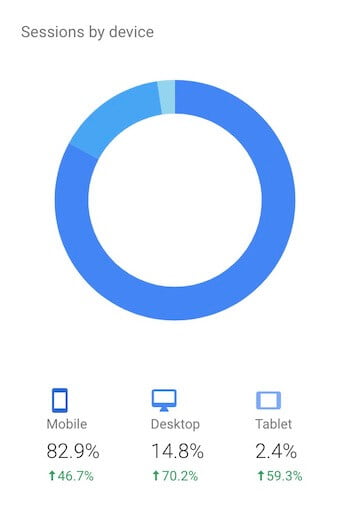
As you can see, about 84% of my traffic comes from mobile, but that’s because I also use Pinterest to drive traffic, not only Google.
How to Make a Mobile Responsive Website
As long as you have a great theme, building a mobile responsive website isn’t difficult at all.
In fact, a great theme will have everything ready to go without you having to mess with any settings.
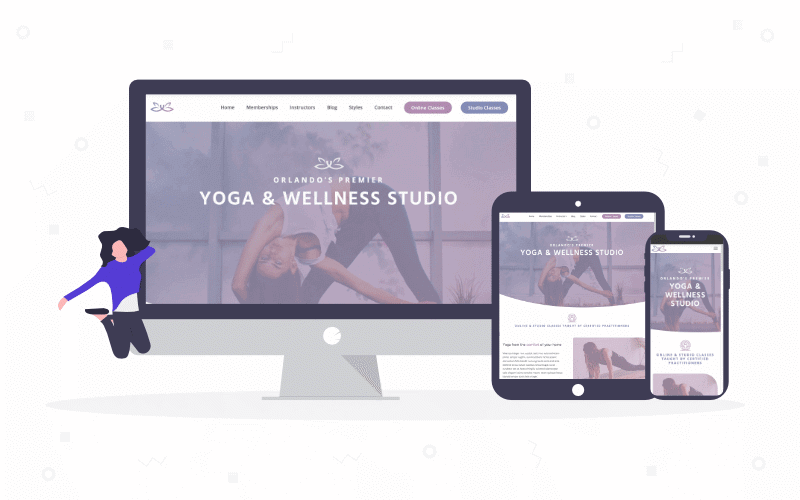
Choosing a bad theme can make things difficult and frustrating.

My top choice for a fast and responsive theme is GeneratePress. This is the theme I use on both of my websites. (my review)
You can check my list of the best WordPress themes here.
6. Write Like You Speak
When learning how to write an About Me page, many bloggers make the mistake of trying to sound too smart.
They end up using a lot of jargon just to sound more professional.
The goal of your About page is to build trust with your audience and stand out by being and sounding like who you are.
7. Use Specific Numbers
When writing an About page, you don’t want to just tell your visitors that your product will help them a lot.
You want to be specific and tell them how much it’ll help them.
For example, saying that your photography course will help them book four weddings each month is a lot more persuasive than simply saying it will help them book a lot of weddings.
8. Include Your Socials
What better way to build trust with your audience than having them follow you on social media?
Platforms like Instagram are great because your readers can see who you are and connect with you in real time.
They can quickly comment on your photos or stories and get a reply from you.
Plus, if you have a ton of followers, you can use it as great social proof.
Now, you want to include this near the end so that your visitors don’t click on them and get distracted and forget to come back to your site.
9. Add Your Contact Details
When learning how to write an About Us page, many bloggers and businesses forget to ad their contact information.
Even though you should have a separate Contact page, it’s good practice to add this information on your About page as well.
Another option would be to just include a link to your Contact page at the end.
Optimizing Your About Me Page for Search Engines
Contrary to what many beginner bloggers believe, Google SEO isn’t only for blog posts.
If you want to get the most out of your About page, you should optimize the content so that it shows up in search engines when people look for you.
If the value you provide to your audience is closely tied to a group of keywords, you can use those keywords throughout your About Me page.
For example, let’s say your target keyword is “weight loss coach.” You could write your About page headline like this:
The Weight Loss Coach Who Will Keep the Weight Off
Keyword Cannibalization
An important thing to note, though, is that you don’t want to optimize for the same keyword for both your Homepage and About page.
If you’ve optimized your Homepage with the term “Weight Loss Coach,” try using something like “Fat Loss Coach” for your About page.
Optimizing pages or blog posts for similar terms is called keyword cannibalization and can affect your Google rankings.
About Me Page Examples
1. ConvertKit – About Us Page Example
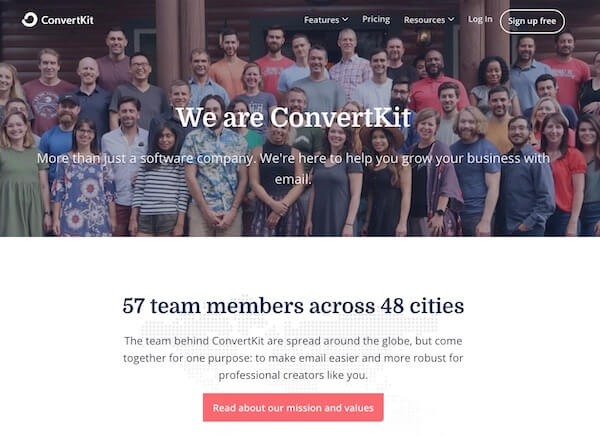
What I Like:
- Clear subheading telling you they’re an email marketing company. “We’re here to help you grow your business with email.”
- Most important points are above the fold.
- Who their site’s for. “for professional creators like you.”
- Big call-to-action at the end
2. CreativeLive – About Page Example
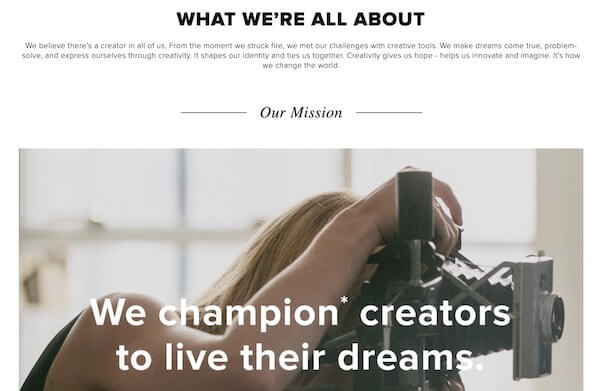
What I Like:
- The huge image with their mission statement is definitely powerful and eye-catching.
- They make it clear their target audience are creators wanting to learn.
- Tons of high-quality images and videos that keep visitors engaged.
- Their brand’s timeline is displayed in a very creative and funny way.
3. Nike – About Us Page Example
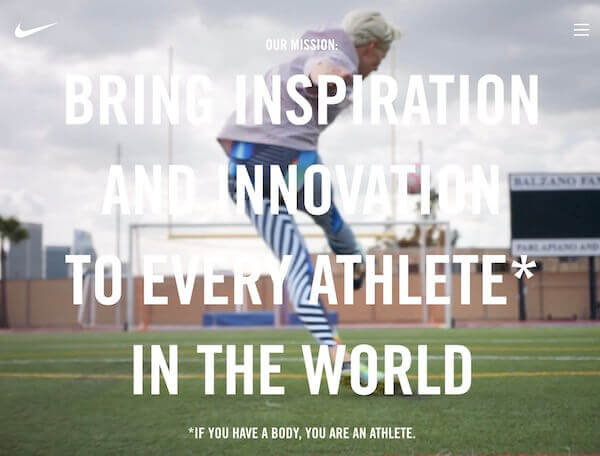
What I Like:
- They greet you with a video that takes up the whole screen and displays their mission.
- Lots of white space between sections that make the text easier to read and keep the focus on one thing at a time.
- They mention how they’re helping local communities.
4. Adidas – About Page Example
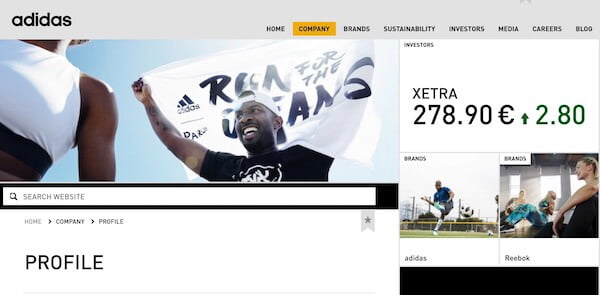
What I Like:
- They have an eye-catching infographic that displays all their information
What I Don’t Like:
- They have too many elements on the sidebar causing their site to look Messi (pun intended).
- Their page looks very outdated.
- Too many elements fighting for attention.
5. Lonely Planet – About Page Example
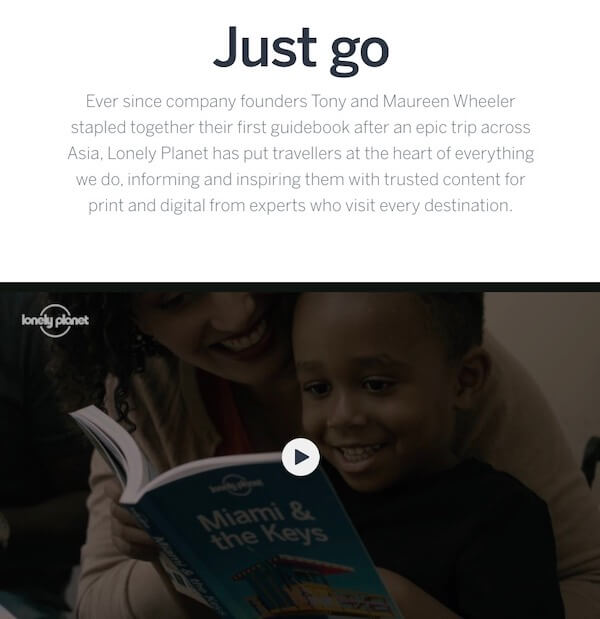
What I like:
- Opening with a quick story about how they came to be.
- Engaging video right below the fold.
- Lots of white space between sections to keep the focus on one item at a time.
6. Girlboss – About Page Example

What I Like:
- Clearly state their mission and who their website is for.
- Sections are very well divided, which makes the page easy to read and navigate.
- Images are very colorful and organized, not just thrown all over the place.
- Each one of their values is a different heading.
7. Purple Rock Scissors – About Us Page Example
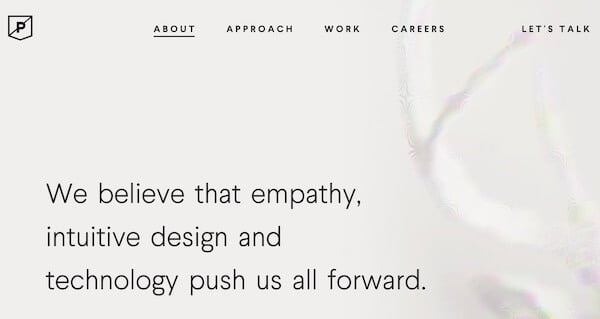
What I Like:
- Very detail-oriented animation when you first open the About page. The word technology “pushes” the word push.
- Subtle animations and effects on each section.
- They mention where they’re located. #theCityBeautiful
- One of my favorite designs on this list.
8. Pinterest – About Us Page Example
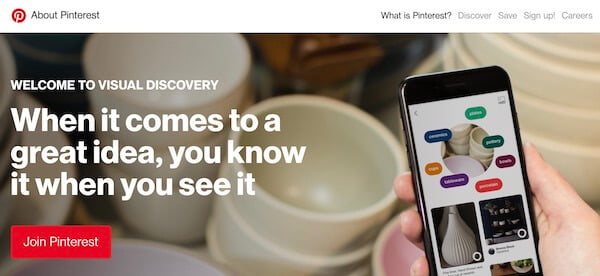
What I Like:
- Attention grabbing call-to-action above the fold. I believe this works great for them because Pinterest is well-known and what they’re offering is free. I don’t recommend opening your About Me page with a call-to-action unless you’re giving something valuable that doesn’t require visitors to enter their email.
What I Don’t Like:
- There’s nothing else on their About page besides the call-to-action and what’s new on Pinterest.
9. Creative Market – About Page Example
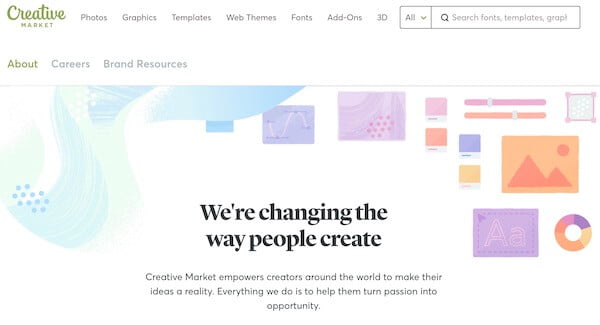
What I Like:
- Right off the bat, you know they’re targeting creators.
- Lots of colorful graphics that don’t overlap with the text.
- They mention how easy it is for creators to make a living anywhere in the world. This will get the attention of creators who think they need to be experts to make a living.
- They show specific numbers when talking about results from creators using their platform.
- When it comes to hitting all the information a killer About Me page should have, this company knows what’s up.
10. 7Sigma Physiques – About Page Example
Okay, this is actually my fitness site so I’ll probably be a little biased, heh.
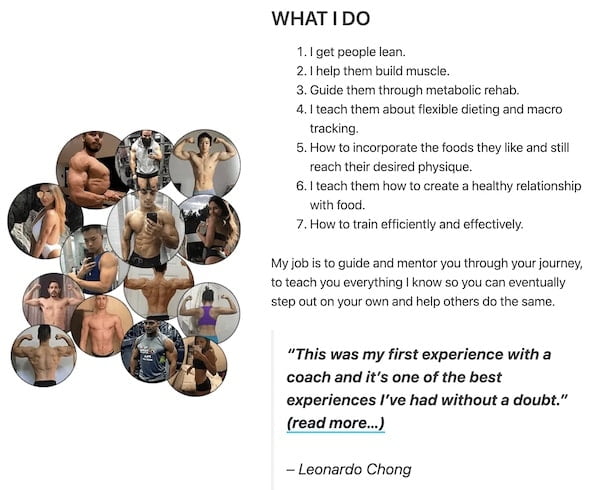
What I Like:
- It shows people what I can do for them right from the start.
- It includes a testimonial and images of some clients all above the fold.
- It says what my values are and shows a picture of me volunteering with kids and adults with special needs.
- More personal information about me is at the end.
11. Liz Pinto – About Me Page Example

What I Like:
- She welcomes you with a motivational quote and high-quality photos of her in action.
- It’s clear from the start that her website is about photography.
- She includes a call-to-action at the end to check out her photography courses.
12. Kitchen Sink – About Us Page Example

What I Like:
- They use bullet points to list their services, which makes it super easy to read.
- How they play with color contrast.
- Their call-to-actions really pop out and get your attention.
- How they get your attention with massive colored headings.
- They include their contact information at the end.
What I Don’t Like:
- They don’t include testimonials or results from their clients.
13. Bodybuilding.com – About Us Page Example
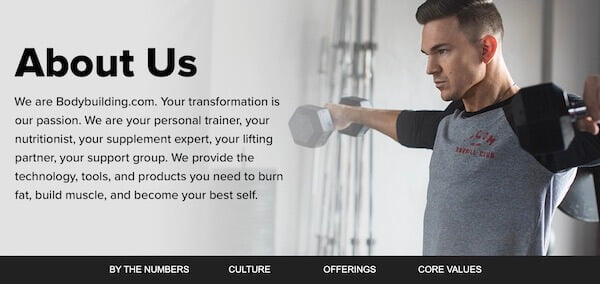
What I Like:
- They immediately tell you how they can help you transform your body.
- Easy navigation to other sections on their About page.
- They show plenty of social proof.
- They show you their free workout and nutrition articles and videos.
14. Bad Yogi – About Page Example
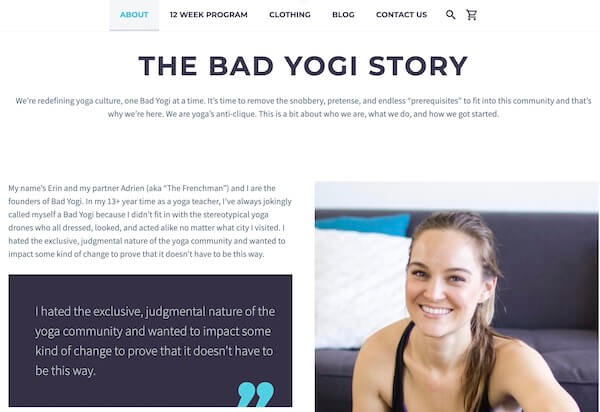
What I Like:
- They quickly mention what sets them apart from other Yoga communities.
- I love how Erin tries to resonate with people who might feel like they don’t fit with the “normal” yoga community.
Final Thoughts on How to Write an About Page
Learning how to write a killer About Me page is something many bloggers and businesses take for granted.
But as you’ve learned from this article, it is quite important to get this right.
Your About page is where visitors will come to learn more about how you can fix their issues.
Before closing out this blog post, let’s quickly go over the steps to write an awesome About page:
- Write an engaging headline
- Tell people how you can help them
- Tell them who your website is for
- Explain what they’ll learn in your blog posts
- Add testimonials or other social proof (if you have any)
- Talk about your values and how you got where you are
- Add a powerful call-to-action
- Make your About Me page SEO-friendly
I really hope you enjoyed this blog post on how to write an About page.
Whenever you’re done writing your About page, leave it in the comments section below.
I’d love to check it out!
